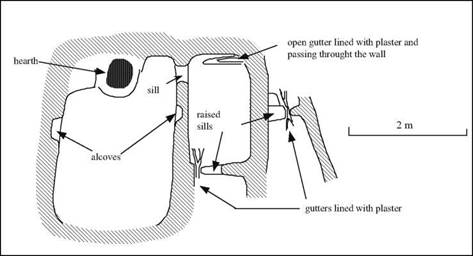Water in the early cities
Another dimension of hydraulics appears in the early cities: that of wastewater drainage. Many medieval and modern civilizations will come to treat this problem casually, and as a result endow their cities with an atmosphere of filth. Yet the early civilizations of the East were precocious in their concern for urban drainage. Evidence of the oldest known systems for draining water from houses can be found as early as the end of the Neolithic period, around 6500 BC, at El-Kowm.[24] These comprise plaster-lined gutters dug into the ground and crossing the doorsills, as well as holes pierced through walls, and even passages below the hard surface of the ground (Figure 1.4).
Mohenjo-Daro, in the Indus valley, gives us a particularly striking example of such hydraulic works at the scale of an entire city. Here there are about 700 cylindrical wells more than 15 m deep, often located within the houses themselves. Such houses are provided with bathing rooms and often with latrines. The wastewater (including from the rooms above the ground floor) is drained through clay pipes which obliquely pass through the massive walls to connect to gutters covered with slabs, water being then conveyed into brick-covered passages dug underneath the walks between houses, and finally into larger collectors. In these drainage systems, settling basins prevent blockage by debris. In alleys and passageways that are not on the drainage system, large bottomless urns serve as cesspools.[25]
A number of the early cities of Mesopotamia, at the end of the IVth or beginning of the IIIrd millennium BC, are similarly endowed with networks of wastewater and stormwater drainage.[26] These include Habuba Kebira, Mari, Eshnunna, then Ugarit in the IInd millennium BC (see the maps of Figures 2.1 and 4.1 for the geography of these cities). At Habuba Kebira, which is a Sumerian establishment of a thousand inhabitants founded about 3500 BC and occupied for only a century and a half, various systems are used to drain wastewater. The streets, well maintained and paved with an aggregate of gravel, are equipped with U-shaped gutters made from 64-cm long sections of clay, or sometimes from conduits covered with slabs of stone, draining wastewater and stormwater outside the city walls. Even true conduits made from interlocking sections of clay pipe have been found.[27] At Mari, pipe networks whose total length can be greater than a hundred meters service multiple sanitary installations in the same house. But in Mesopotamia, this preoccupation with drainage seems to have faded away in time.
It is in Crete, in the IInd millennium BC, that we rediscover elaborate systems of water drainage – and for the first time also systems of water supply. We return to these in Chapter 4.
|
Figure 1.5 House with adjoining rooms at El-Kowm (about 6500 BC), with the remnants of drainage systems: the oldest known traces of water conveyance? (adapted from Stordeur, 1989). |







Leave a reply